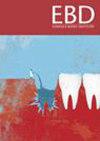How effective is CBCT-guided endodontic access over ‘brain-guided’ accesses, and is this a likely addition to the general dental practitioner’s armamentarium?
Q3 Dentistry
引用次数: 0
Abstract
Non-randomised prospective single-arm controlled clinical trial. The main inclusion criteria for both guided and freehand access groups was pulp canal obliteration (PCO). All teeth underwent cone-beam CT (CBCT) scan prior to access. Null hypothesis was that there is no difference in technical failure between guided and unguided access. The primary outcome was canal location success as a discrete measure (found, not found, perforated). The secondary outcome was conservativeness of drill pathway using discrete measures (optimal precision, acceptable precision, technical failure (included canal not found and perforation)). Patients underwent one subsequent annual follow-up. Patients attended for consultation at one centre (University Hospital Leuven, Belgium). PCO extent was assigned using periapical radiograph followed by CBCT. Cases graded as ‘high difficulty’ (via qualitative assessment) by briefed endodontists within the centre were selected for the study. Control group was taken from historical records as assigning an active patient to the freehand over the guided group was considered unethical. Sample size calculation to achieve conventional 80% power and statistical significance of 0.05% was undertaken, mandating 60 teeth per group. An analysis including all data, without matching, was performed by a generalized linear model for binary data using a logit link function with the primary outcome (canal found or not found/perforation) as response variable and the technique (guided or freehanded) as explanatory variable. p ≤ 0.05 was considered statistically significant. Blinding of operators was not possible. Teeth were matched (paired) per group to achieve group homogeneity. Guided access yielded a 98.3% (n = 59/60) success rate with only one case unsuccessful (canal not found). In comparison, freehand access yielded 81% (n = 59/73) success rate, with 9.5% (n = 7/73) of teeth with canals unfound, and 9.5% (n = 7/73) of teeth perforated. Null hypothesis rejected given statistical significance of results (p = 0.011). Cases presenting with PCO that undergo guided access show optimal outcomes both from an endodontic and from a conservational perspective, with significant increased chances of canal location in a conservative manner. Freehand correction in guided access cases can be used to inform changes to initial guided access if the canal is not found.cbt引导下的牙髓治疗比“大脑引导”的效果如何?这可能是普通牙科医生装备的补充吗?
设计:非随机前瞻性单臂对照临床试验。引导组和徒手组的主要入组标准均为髓管闭塞(PCO)。所有牙齿均行锥形束CT (CBCT)扫描。零假设是在有引导和无引导的通道之间没有技术故障的差异。主要结果是将根管定位成功作为一项离散测量(发现、未发现、穿孔)。次要结果是使用离散测量(最佳精度、可接受精度、技术故障(包括未找到管和穿孔))的钻径的保守性。患者随后每年进行一次随访。病例选择:在一个中心(比利时鲁汶大学医院)就诊的患者。通过根尖周x线片和CBCT确定PCO范围。由中心内的牙髓专家评定为“高难度”(通过定性评估)的病例被选为研究对象。对照组取自历史记录,因为将活跃患者分配到徒手组而不是引导组被认为是不道德的。数据分析:进行样本量计算,达到常规80%的功效,统计学显著性为0.05%,每组60颗牙。采用logit链接函数对二元数据进行广义线性模型分析,包括所有数据,不进行匹配,以主要结果(发现或未发现根管/穿孔)作为响应变量,以技术(引导或徒手)作为解释变量。P≤0.05认为有统计学意义。对操作人员进行蒙蔽是不可能的。每组进行牙齿匹配(配对)以达到组内均匀性。结果:引导下入路成功率为98.3% (n = 59/60),未找到根管1例。徒手入路的成功率为81% (n = 59/73),有9.5% (n = 7/73)的牙齿未发现根管,9.5% (n = 7/73)的牙齿穿孔。考虑到结果的统计学显著性(p = 0.011),拒绝原假设。结论:从根管学和保守的角度来看,有PCO的病例接受引导通路均显示最佳结果,保守方式下根管定位的机会显著增加。徒手矫正在引导通路的情况下,可用于通知更改初始引导通路,如果没有找到管。
本文章由计算机程序翻译,如有差异,请以英文原文为准。
求助全文
约1分钟内获得全文
求助全文
来源期刊

Evidence-based dentistry
Dentistry-Dentistry (all)
CiteScore
2.50
自引率
0.00%
发文量
77
期刊介绍:
Evidence-Based Dentistry delivers the best available evidence on the latest developments in oral health. We evaluate the evidence and provide guidance concerning the value of the author''s conclusions. We keep dentistry up to date with new approaches, exploring a wide range of the latest developments through an accessible expert commentary. Original papers and relevant publications are condensed into digestible summaries, drawing attention to the current methods and findings. We are a central resource for the most cutting edge and relevant issues concerning the evidence-based approach in dentistry today. Evidence-Based Dentistry is published by Springer Nature on behalf of the British Dental Association.
 求助内容:
求助内容: 应助结果提醒方式:
应助结果提醒方式:


